- Travel + Photos
- Voyages
- Italy
Italy: Florence, Pisa & Siena

I don't really know why I have never visited Italy before. I have been to all of the other neighbouring countries though: the Benelux, Germany, Switzerland, Spain and even England. But Italy ... ? Sure, on a few occasions, I have ventured to the other side of the Mont Blanc tunnel, just far enough to get some jambon from the valley of Aosta. Note: do not confuse jambon of Aosta (or Valle d'Aosta Jambon de Bosse, an EU protected designation of origin) with Jambon Aoste which is an industrial product from the municipality of Aoste in Isère, France.
At the end of 2012, my brother suggested to spend Christmas holidays in Florence. So here I am, visiting Italy for the first time. The trip transports us several hundreds years back, at the medieval time, where power and wealth were prevalent in this region of Tuscany.
Pisa
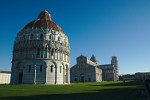
We start with Pisa since our flight from Paris could not land in Florence because of the fog and was routed to Pisa instead. While Florence, more inland, was covered by a heavy layer of fog, Pisa was bathing under a golden sun on the coast.
The rise and the decline of the Republic of Pisa are largely tied to its maritime power. Having established its port at the mouth of the Arno river, Pisa rapidly increased its maritime power at the beginning of the 11th century. For a while, Pisa controlled the Tyrrhenian Sea and western Mediterranean Sea, and its commerce prospered. Pisa reached the peak of its splendour between the 12th and 13th centuries, and contended then with the Republics of Venice and of Geona. But a crushing defeat in 1248 against Geona destroyed most of its navy fleet and triggered the beginning of its decline.
Nowadays, Pisa is known more for its Leaning Tower than for its glorious past, or than for being Galileo's place of birth. Yet, the construction of the Leaning Tower, and the other monuments at the Piazza del Duomo, was possible only thanks to the wealth at the peak of the splendour of the Republic of Pisa.
Florence (Firenze)
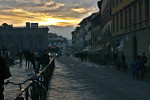
A visit to Florence is really a visit back in time of the House of Medici, whose power emerged during the Italian Renaissance period. Their success is remarkable: they start in the commerce, become rich bankers, then infiltrate into politics, to finally emerge as member of the clergy and nobles. In the end, they produced two Popes (Leo X and Clement VII), two queens of France (Catherine de Medici and Marie de Medici) and numerous dukes of Florence and grand dukes of Tuscany (too many to list them all here). It's very remarkable that a family could have that much influence on Italy and Europe for that many centuries.
On the arts side, the Medici were adept of patronage and of collectionism. Anna Maria Luisa de Medici (1667-1743), the last scion of the House of Medici, donated all of her possession, thus of the fabulous heritage of the Medici, to the State of Tuscany under the condition that nothing leaves the city of Florence and that the collections be open to the public.
Florence, cradle of the Renaissance in Italy and the capital of Tuscany, offers thereby a great deal of artistic wealth. The town is a delight for amateurs of architecture and of the beaux arts. The flip side is that queues at the museums can be very long; the time one spends waiting in line to get in is the time one doesn't have to explore the exhibitions.
Siena
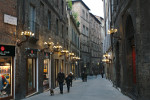
Siena is a medieval town located 70 km (53 mi) south of Florence. Siena is founded on the hills, a little like Rome. Legend has it that Sienus and Aschius, sons of Remus (founder of Rome with his brother Romulus) fled Rome in order to escape the anger of their uncle Romulus on two horses, one black and the other white. They stop in the valley of Tressa and founded the town of Siena, baptised to the name of the elder bother. That explains why black and white are the colours of the city and the she-wolf suckling Romulus and Remus is the symbol of the city.
Siena is known for its artistic heritage and its spectacular horse race: Palio delle Contrade (or simply il Palio). However, we couldn't see much on that Christmas day beside the historical centre of the city as museums and monuments were all closed. Only the Duomo, where Christmas masses were taking place, was open. The town remains charming despite the rain and the gloomy skies. I wonder how the city looks like on a sunny day, where one could see the other hills.
The Duomos
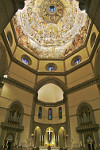
Duomo (dome) comes from Latin domus, which means house. Duomo is the name given to the principal church of the city (in the sense of the house of God), which often is - but not always - a cathedral. It is without surprise that, in all of the cities we have visited, there is a Duomo in the historical centre of town. All three duomos have marble façades, a campanile (tower containing one or more bells, among which is the famous Leaning Tower) and a baptistery.
The Santa Maria Assunta (Our Lady of the Assumption) cathedral, or Duomo di Sienna, was built in the 13th century. Of Gothic style, its façade ornamented with fine sculptures is impressive. Its interior is sumptuous as well. Contrary to the duomos in Pisa and Florence, the tower and the baptistery are not separate from the cathedral, thus technically speaking the tower is not a campanile.
If the Leaning Tower of Pisa is well known worldwide (ironically the incline that makes it famous is the result of a mishap, not the product of its design), the centrepiece of the Piazza dei Miracoli is really the Santa Maria Assunta cathedral. The Duomo, of Roman style, was built in the 11th century thanks to one tenth of the loot taken from Palermo. And that wealth of Pisa is also well represented by the interior of the Duomo.
In my mind, the Basilica Santa Maria del Fiore (Saint Mary of the Flower, built in the 13th - 14th centuries) in Florence is the most beautiful of the three. Its façade is very sober although ornate with sophisticated details. Its interior radiates a simple beauty, and without superfluous decoration, appears vast (to be fair, I must mention that the Duomo of Florence is the fifth biggest church in Europe). Sophistication in simplicity - if that really means anything.
Practical details
Dates of the trip: 22-26 December 2012
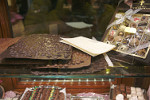
It's not worth having a car when visiting Italian cities. In most cities, only authorized vehicles may circulate in the city centre. If you venture into a zona a traffico limitato (restricted traffic zone), you risk being caught by traffic cameras and get a fine in the mail - often several months later. Parking in town is also a headache. Parking buildings are few and often full. And street parking is not any better.
Trains, buses and taxis are on par with everywhere else in Europe. Nothing specal here, move along.
Leave your tripod with your checked-in luggages. I have always taken a tripod with me as a carry-on item and have never had any trouble at all the airports I have been to around the world. But when leaving Florence, security would not let me pass the embarking gate with my tripod because they consider it a potential weapon. Go figure!
Copyright © 2013, Northwest Summit. All rights reserved.
No part of this page may be reproduced, republished or copied without the express written permission of its author.


